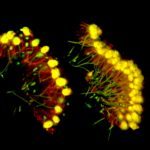Link to Pubmed [PMID] – 27906129
Link to DOI – 10.7554/eLife.19607
Elife 2016 Dec; 5():
The dichotomy between smooth and striated myocytes is fundamental for bilaterian musculature, but its evolutionary origin is unsolved. In particular, interrelationships of visceral smooth muscles remain unclear. Absent in fly and nematode, they have not yet been characterized molecularly outside vertebrates. Here, we characterize expression profile, ultrastructure, contractility and innervation of the musculature in the marine annelid Platynereis dumerilii and identify smooth muscles around the midgut, hindgut and heart that resemble their vertebrate counterparts in molecular fingerprint, contraction speed and nervous control. Our data suggest that both visceral smooth and somatic striated myocytes were present in the protostome-deuterostome ancestor and that smooth myocytes later co-opted the striated contractile module repeatedly – for example, in vertebrate heart evolution. During these smooth-to-striated myocyte conversions, the core regulatory complex of transcription factors conveying myocyte identity remained unchanged, reflecting a general principle in cell type evolution.

